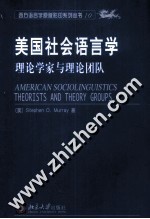

美国社会语言学 理论学家与理论团队PDF电子书下载
- 电子书积分:12 积分如何计算积分?
- 作 者:(美)默里著
- 出 版 社:北京:北京大学出版社
- 出版年份:2004
- ISBN:7301068824
- 页数:339 页
CHAPTER 1 1
Introduction 1
CHAPTER 2 4
Theory Groups in Science 4
2.1 Groups and'revolutions' 4
2.2 Institutionalization 6
2.3 Invisible Colleges and Scientific Networks 8
2.3.1 Sociological specification of Kuhn's model 9
2.3.2 Weighing the variables 11
2.3.3 Formalization of the Griffith-Mullins Theory 14
2.3.3.1 Prerequisites of scientific group formation 14
2.3.3.2 The social bases of scientific revolutions 15
2.3.3.3 Representing the theory 17
CHAPTER 3 18
1950s Studies of Lexicons and Psychiatry 18
3.1 The Whorfian Vogue 19
3.2 Studies of Native American Linguistic Acculturation 25
3.3 Morris Swadesh and Lexicostatistics 27
3.4 Berkeley Linguistics during the 1950s 31
3.5 Tragerian Explorations of'Metalinguistics' 32
3.6 The Natural History of an Interview Project 33
3.7 Gregory Bateson and the'Palo Alto School' 36
3.7.1 Theoretical summary 41
3.7.2 Influence 42
3.8 Ray Birdwhistell's Study of Nonverbal Communication 43
3.9 Pike's"Unified Theory"and Burke's Dramaturgical Analysis 45
CHAPTER 4 47
Sociologies of Language 47
4.1 The Chicago School Conception of Language Between the World Wars 48
4.2 Cosmopolitan Communications 49
4.3 Stanley Lieberson 50
4.4 Joyce O.Hertzler 51
4.5 John Reinecke 52
4.6 Ralph Pieris 54
4.7 Catholic University Urban Sociolinguistics 54
CHAPTER 5 57
Language Contact and Early Sociolinguistics 57
5.1 Einar Haugen 58
5.2 Uriel Weinreich 63
5.3 Joshua A.Fishman 66
5.3.1 Students and Peers 70
5.4 Wallace E.Lambert 74
5.5 Roger Brown 79
5.6 Exemplars of Sociolinguistics avant la lettre 88
5.6.1 Address terms 88
5.6.2 Goin'and explaining 89
5.6.3 The Social Functions of Codes in Tucson and Los Angeles 90
5.7 Summary 92
CHAPTER 6 94
The Ethnography of Speaking 94
6.1 The California Network 94
6.1.1 Via Poona 95
6.1.2 William Bright 95
6.1.3 Charles Ferguson 96
6.1.4 John Gumperz 97
6.1.5 Susan Ervin-Tripp 98
6.1.6 Dell Hymes 100
6.1.7 Anthropological linguistics at Berkeley,c.1960 101
6.1.8 Non-contact with symbolic interactionists 103
6.1.9 Summary 104
6.2 The Program 105
6.3 Acceptance of the Line of Work 109
6.3.1 Access to publication 109
6.3.2 Reception of early publications 111
6.4 The First Generation:An Elite Specialty 112
6.5 Foundation of the Center for Applied Linguistics 113
6.6 Foundation of the SSRC Sociolinguistics Committee 114
6.7 Exemplars 118
6.8 Paradigm Shift Under a Rhetoric of Continuity 123
6.8.1 From homogeneous speech communities to continua and repertoires 123
6.8.2 Commuuicative competence and creativity 126
6.8.3 Rhetoric of continuity 131
6.9 The Second Generation 133
6.10 The Continued Non-Integration of Sociologists 137
6.11 Institutionalization and Interdisciplinarity 139
6.12 Theoretical Summary 142
CHAPTER 7 145
Related Perspectives 145
7.1 Erving Goffman 145
7.2 Conversation analysis 155
7.2.1 Theoretical summary 159
7.3 Basil Bernstein 161
7.3.1 The Bernstein group 166
7.3.2 Relationship to American Work 166
7.4 William Labov 167
7.4.1 Training and relation to earlier structuralist linguistics 167
7.4.2 Prestige dialects 170
7.4.3 Black English 174
7.4.4 The context of Labov's work 177
7.5 A (Belated)Note on 20th Century American Dialectology 179
CHAPTER 8 182
Ethnoscience 182
8.1 Genealogy 182
8.2 Ward Goodenough and Floyd Lounsbury 183
8.3 Training 186
8.4 Access to publication 187
8.5 Communication Patterns 188
8.6 Focus and Continuities 188
8.7 Methods 191
8.8 Domains Analyzed 193
8.9 'Hocus Pocus'and Other Charges 198
8.10 Disintegration 201
8.11 Theoretical Summary 206
CHAPTER 9 210
1980s University of California Ethnolinguistics 210
9.1 'Gumperzology':the study of inter-ethnic miscommunication 210
9.2 Interpretive Sociolinguistics:Deborah Tannen 220
9.3 'Cultural Consensus':The new ethnolinguistic formalism 224
CHAPTER 10 235
Midwestern Semiotics and Georgetown Pragmatics 235
10.1 Indiana University 235
10.2 Chicago Work on Reference and Entextualuization 236
10.3 Georgetown University's Sociolinguistics Program 239
CHAPTER 11 240
The Turn Away from Language in Contemporary American Anthropology 240
CHAPTER 12 247
Conclusions 247
12.1 Testing the Functionalist Model 247
12.2 Accounting for Revolutions 248
12.2.1 Recruitment 248
12.2.2 Perceived Access to Recognition 249
12.3 Co-ordination and Longevity of Theory Groups 251
12.3.1 Multicenteredness 251
12.3.2 Interdisciplinarity 252
12.4 Summary 253
12.5 Other Variables 254
12.5.1 Scientific'Revolutions' 255
12.5.2 Institutionalization 256
12.5.3 Marginality 257
An Appendix on Methods 259
1.Why These Scholars?The Genesis of This Research 259
2.Data Sources 261
3.Interpreting 264
4.Causality 266
Bibliography 267
Index 328
- 《SQL与关系数据库理论》(美)戴特(C.J.Date) 2019
- 《联吡啶基钌光敏染料的结构与性能的理论研究》李明霞 2019
- 《情报学 服务国家安全与发展的现代情报理论》赵冰峰著 2018
- 《英汉翻译理论的多维阐释及应用剖析》常瑞娟著 2019
- 《一个数学家的辩白》(英)哈代(G.H.Hardy)著;李文林,戴宗铎,高嵘译 2019
- 《新课标背景下英语教学理论与教学活动研究》应丽君 2018
- 《党员干部理论学习培训教材 理论热点问题党员干部学习辅导》(中国)胡磊 2018
- 《虚拟流域环境理论技术研究与应用》冶运涛蒋云钟梁犁丽曹引等编著 2019
- 《当代翻译美学的理论诠释与应用解读》宁建庚著 2019
- 《程序逻辑及C语言编程》卢卫中,杨丽芳主编 2019
- 《大学计算机实验指导及习题解答》曹成志,宋长龙 2019
- 《指向核心素养 北京十一学校名师教学设计 英语 七年级 上 配人教版》周志英总主编 2019
- 《大学生心理健康与人生发展》王琳责任编辑;(中国)肖宇 2019
- 《大学英语四级考试全真试题 标准模拟 四级》汪开虎主编 2012
- 《大学英语教学的跨文化交际视角研究与创新发展》许丽云,刘枫,尚利明著 2020
- 《北京生态环境保护》《北京环境保护丛书》编委会编著 2018
- 《复旦大学新闻学院教授学术丛书 新闻实务随想录》刘海贵 2019
- 《大学英语综合教程 1》王佃春,骆敏主编 2015
- 《大学物理简明教程 下 第2版》施卫主编 2020
- 《指向核心素养 北京十一学校名师教学设计 英语 九年级 上 配人教版》周志英总主编 2019
